Abstract
The minimal inhibitory concentrations of nine antimicrobial agents was determined for over 750 clinical isolates of the Bacteroides fragilis group of anaerobic bacteria collected from nine centers in the United States during 1981. High resistance rates were documented for cefoperazone, cefotaxime, and tetracycline. Cefoxitin had the best activity of the beta-lactam antibiotics, whereas moxalactam and piperacillin had good activities. The resistance rate for clindamycin was 6%. There were no metronidazole- or chloramphenicol-resistant isolates encountered. There were significant differences in susceptibility among the various species of the B. fragilis group, particularly with moxalactam, cefoxitin, and clindamycin. Clustering of clindamycin-, piperacillin-, and cefoxitin-resistant isolates was observed at different hospitals. The variability of resistance rates with the beta-lactam antibiotics and clindamycin indicates that susceptibility testing of significant clinical isolates should be performed to define local resistance patterns.
Full text
PDF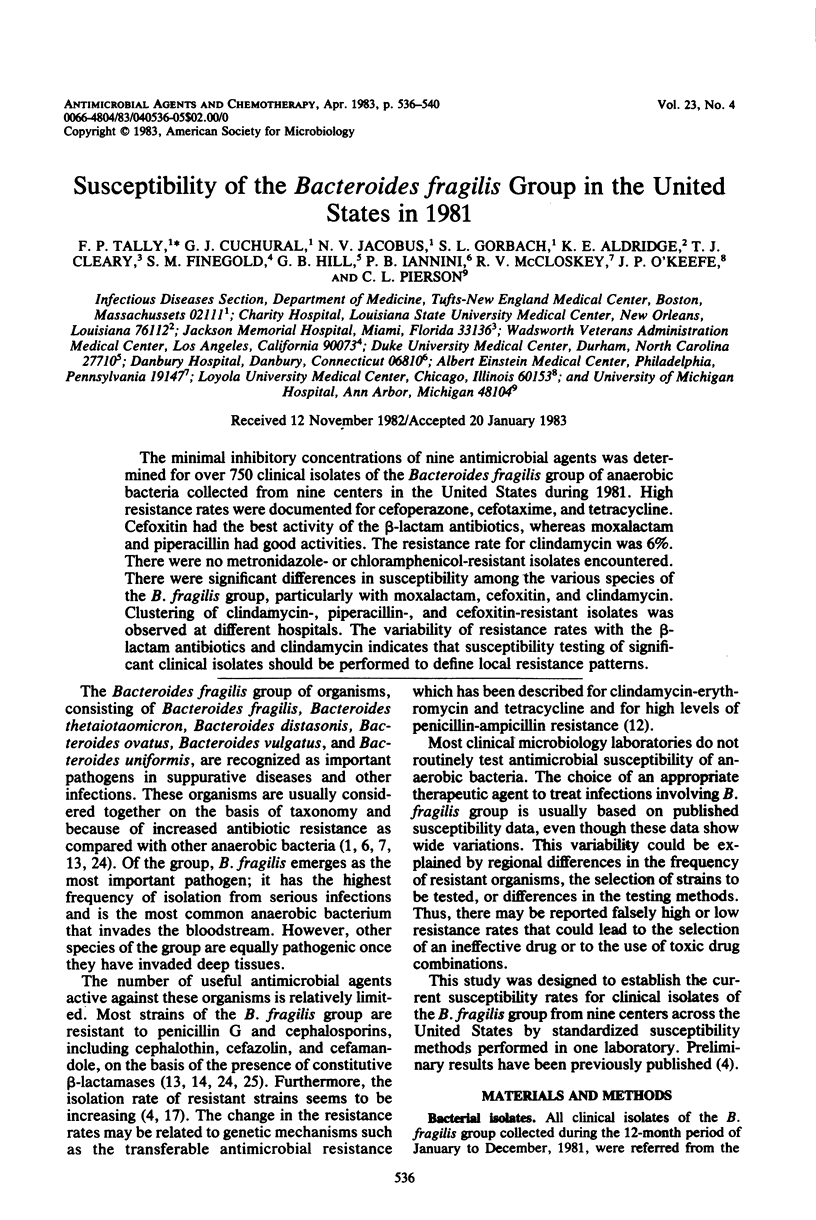
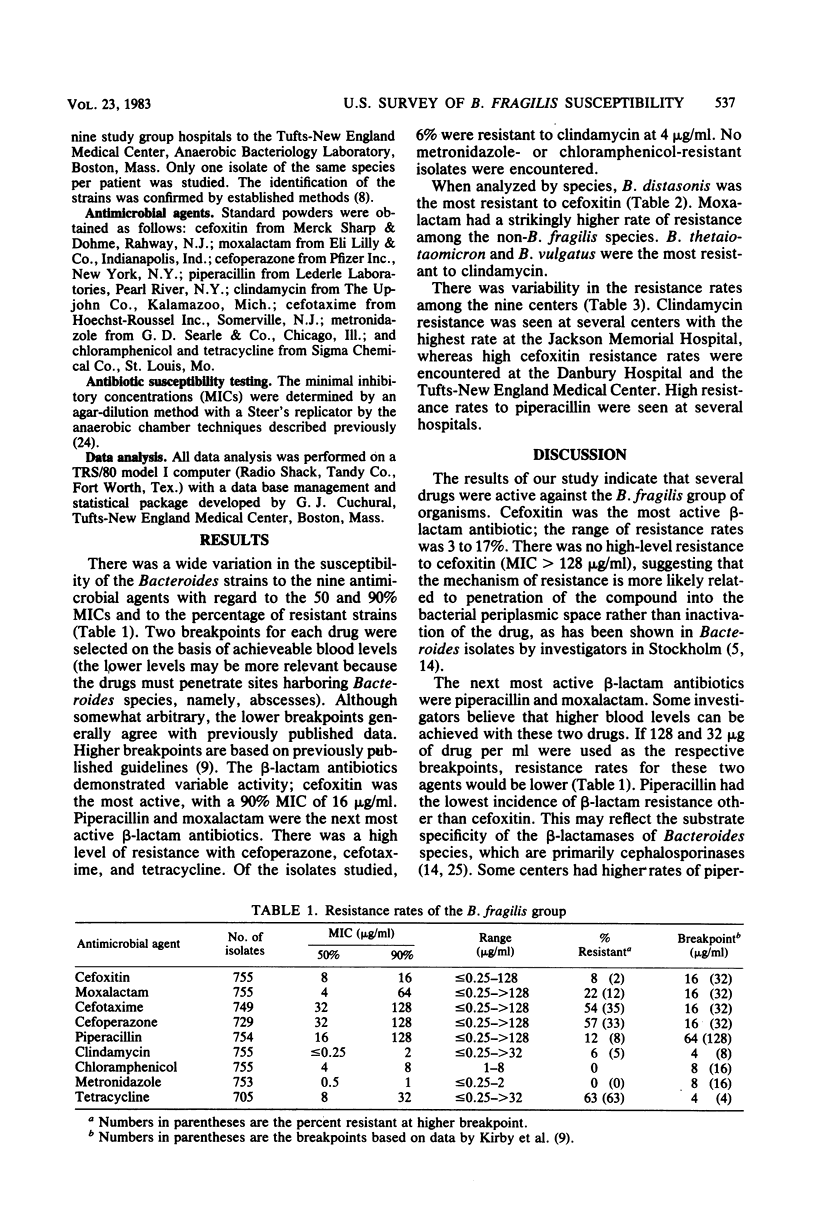
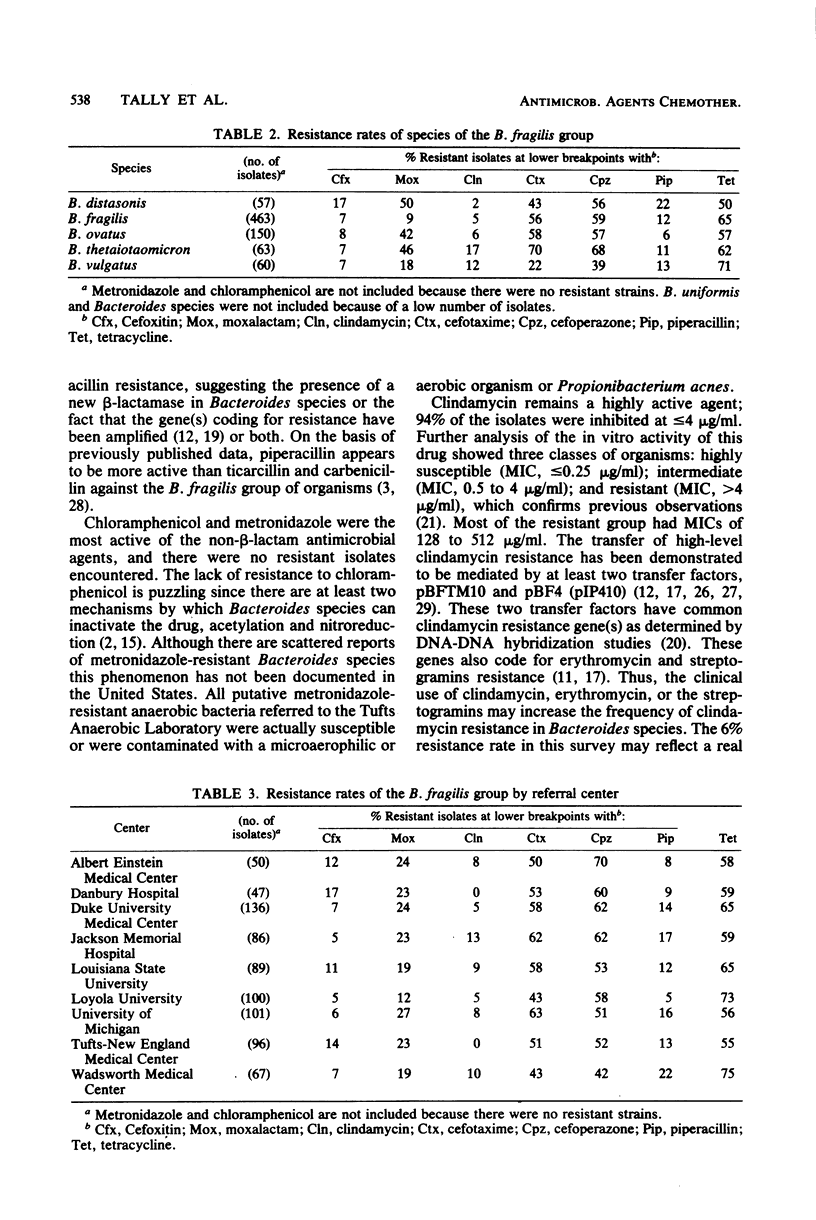
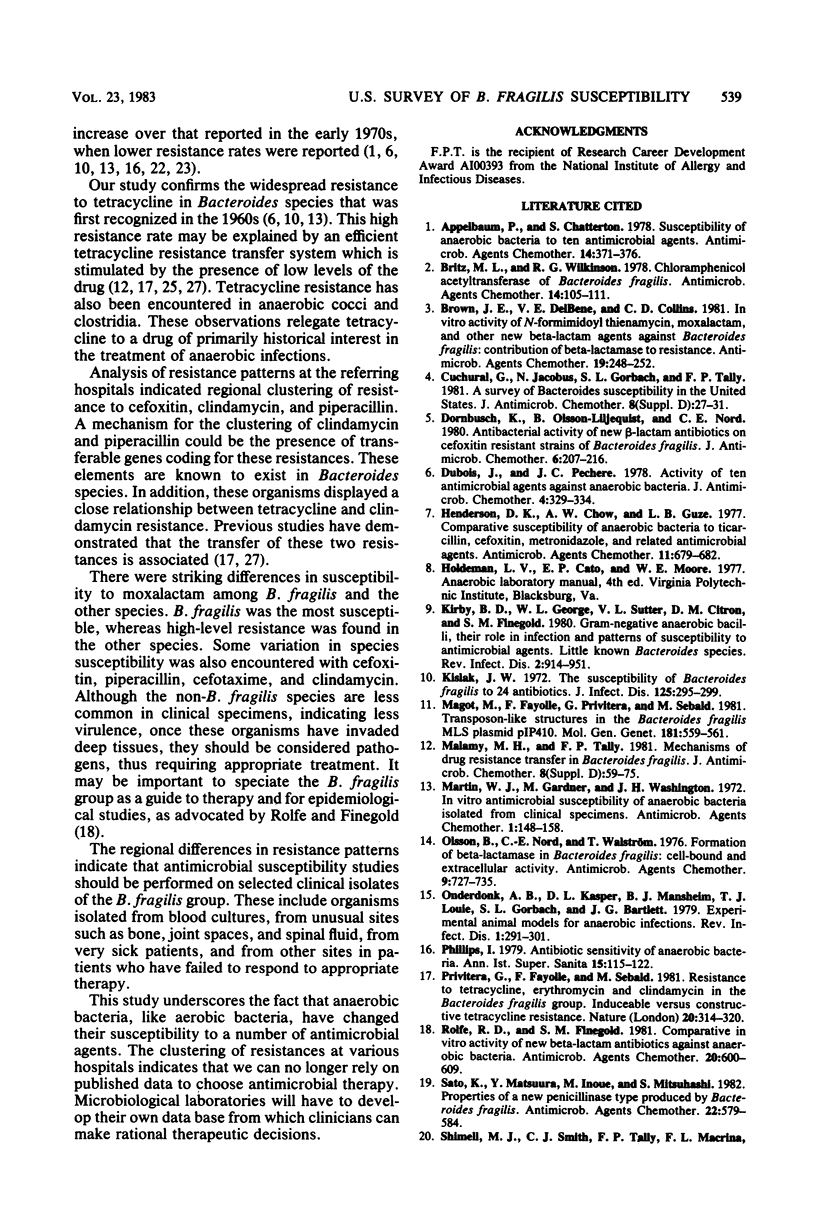
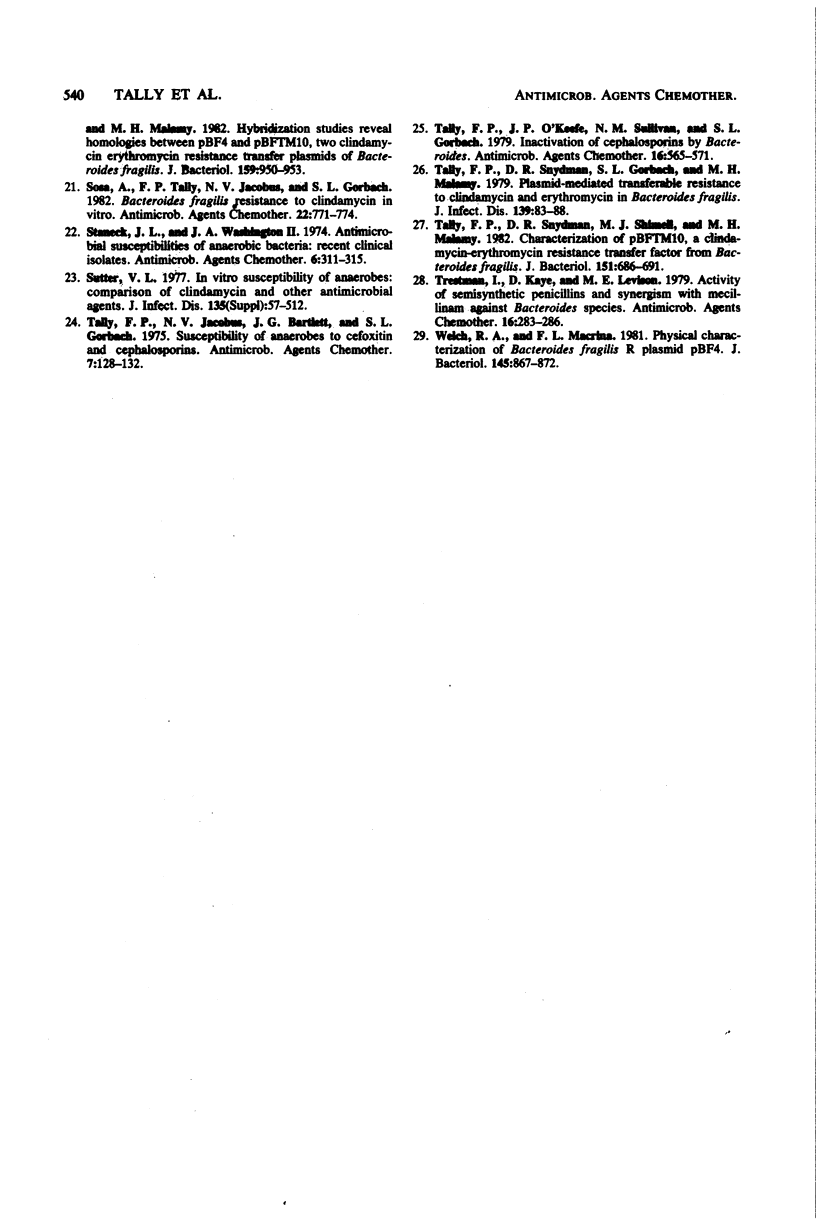
Selected References
These references are in PubMed. This may not be the complete list of references from this article.
- Appelbaum P. C., Chatterton S. A. Susceptibility of anaerobic bacteria to ten antimicrobial agents. Antimicrob Agents Chemother. 1978 Sep;14(3):371–376. doi: 10.1128/aac.14.3.371. [DOI] [PMC free article] [PubMed] [Google Scholar]
- Britz M. L., Wilkinson R. G. Chloramphenicol acetyltransferase of Bacteroides fragilis. Antimicrob Agents Chemother. 1978 Jul;14(1):105–111. doi: 10.1128/aac.14.1.105. [DOI] [PMC free article] [PubMed] [Google Scholar]
- Brown J. E., Del Bene V. E., Collins C. D. In vitro activity of N-formimidoyl thienamycin, moxalactam, and other new beta-lactam agents against Bacteroides fragilis: contribution of beta-lactamase to resistance. Antimicrob Agents Chemother. 1981 Feb;19(2):248–252. doi: 10.1128/aac.19.2.248. [DOI] [PMC free article] [PubMed] [Google Scholar]
- Cuchural G., Jacobus N., Gorbach S. L., Tally F. P. A survey of Bacteroides susceptibility in the United States. J Antimicrob Chemother. 1981 Dec;8 (Suppl 500):27–31. doi: 10.1093/jac/8.suppl_d.27. [DOI] [PubMed] [Google Scholar]
- Dornbusch K., Olsson-Lijequist B., Nord C. E. Antibacterial activity of new beta-lactam antibiotics on cefoxitin-resistant strains of Bacteroides fragilis. J Antimicrob Chemother. 1980 Mar;6(2):207–216. doi: 10.1093/jac/6.2.207. [DOI] [PubMed] [Google Scholar]
- Dubois J., Pechère J. C., Turgeon P. Activity of ten antimicrobial agents against anaerobic bacteria. J Antimicrob Chemother. 1978 Jul;4(4):329–334. doi: 10.1093/jac/4.4.329. [DOI] [PubMed] [Google Scholar]
- Henderson D. K., Chow A. W., Guze L. B. Comparative susceptibility of anaerobic bacteria to ticarcillin, cefoxitin, metronidazole, and related antimicrobial agents. Antimicrob Agents Chemother. 1977 Apr;11(4):679–682. doi: 10.1128/aac.11.4.679. [DOI] [PMC free article] [PubMed] [Google Scholar]
- Kirby B. D., George W. L., Sutter V. L., Citron D. M., Finegold S. M. Gram-negative anaerobic bacilli: their role in infection and patterns of susceptibility to antimicrobial agents. I. Little-known Bacteroides species. Rev Infect Dis. 1980 Nov-Dec;2(6):914–951. doi: 10.1093/clinids/2.6.914. [DOI] [PubMed] [Google Scholar]
- Kislak J. W. The susceptibility of Bacteroides fragilis to 24 antibiotics. J Infect Dis. 1972 Mar;125(3):295–299. doi: 10.1093/infdis/125.3.295. [DOI] [PubMed] [Google Scholar]
- Magot M., Fayolle F., Privitera G., Sebald M. Transposon-like structures in the Bacteroides fragilis MLS plasmid plP 410. Mol Gen Genet. 1981;181(4):559–561. doi: 10.1007/BF00428754. [DOI] [PubMed] [Google Scholar]
- Malamy M. H., Tally F. P. Mechanisms of drug-resistance transfer in Bacteroides fragilis. J Antimicrob Chemother. 1981 Dec;8 (Suppl 500):59–75. doi: 10.1093/jac/8.suppl_d.59. [DOI] [PubMed] [Google Scholar]
- Martin W. J., Gardner M., Washington J. A., 2nd In vitro antimicrobial susceptibility of anaerobic bacteria isolated from clinical specimens. Antimicrob Agents Chemother. 1972 Feb;1(2):148–158. doi: 10.1128/aac.1.2.148. [DOI] [PMC free article] [PubMed] [Google Scholar]
- Olsson B., Nord C. E., Wadström T. Formation of beta-lactamase in Bacteroides fragilis: cell-bound and extracellular activity. Antimicrob Agents Chemother. 1976 May;9(5):727–735. doi: 10.1128/aac.9.5.727. [DOI] [PMC free article] [PubMed] [Google Scholar]
- Onderdonk A. B., Kasper D. L., Mansheim B. J., Louie T. J., Gorbach S. L., Bartlett J. G. Experimental animal models for anaerobic infections. Rev Infect Dis. 1979 Mar-Apr;1(2):291–301. doi: 10.1093/clinids/1.2.291. [DOI] [PubMed] [Google Scholar]
- Phillips I. Antibiotic sensitivity of anaerobic bacteria. Ann Ist Super Sanita. 1979;15(1):115–122. [PubMed] [Google Scholar]
- Privitera G., Fayolle F., Sebald M. Resistance to tetracycline, erythromycin, and clindamycin in the Bacteroides fragilis group: inducible versus constitutive tetracycline resistance. Antimicrob Agents Chemother. 1981 Sep;20(3):314–320. doi: 10.1128/aac.20.3.314. [DOI] [PMC free article] [PubMed] [Google Scholar]
- Rolfe R. D., Finegold S. M. Comparative in vitro activity of new beta-lactam antibiotics against anaerobic bacteria. Antimicrob Agents Chemother. 1981 Nov;20(5):600–609. doi: 10.1128/aac.20.5.600. [DOI] [PMC free article] [PubMed] [Google Scholar]
- Sato K., Matsuura Y., Inoue M., Mitsuhashi S. Properties of a new penicillinase type produced by Bacteroides fragilis. Antimicrob Agents Chemother. 1982 Oct;22(4):579–584. doi: 10.1128/aac.22.4.579. [DOI] [PMC free article] [PubMed] [Google Scholar]


